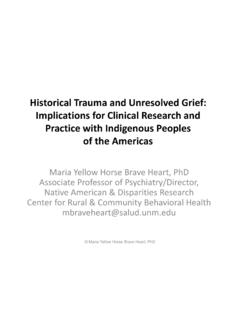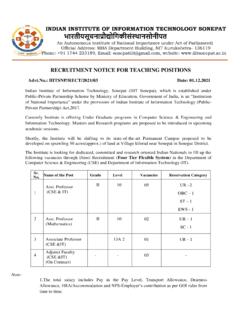Transcription of Facts About American Indian Education
1 8333 Greenwood Blvd., Denver, CO 80221(303) 426-8900 American Indian Education As a result of living in remote rural areas, American indians living on reservations have limited access to higher Education . One-third of American indians live on reservations, according to the Census Bureau. The number of American Indian /Alaska Native students enrolled in colleges and universities more than doubled in the past 30 years, along with the number of associate s, bachelor s, and master s degrees conferred to Natives over the past 25 years. Yet American Indian /Alaska Natives were less likely to earn a bachelor s degree or higher than their non-Native peers, accounting for less than one percent of those who have earned a bachelor s degree, compared to of whites, of African Americans, of Hispanics, and of Asian and Pacific Islanders.
2 Sources: National Center for Education Statistics, Status and Trends in the Education of American indians and Alaska Natives, 2008; National Congress of American indians , 2006; National Center for Education Statistics, 2005; Department of Education , Institute of Education Sciences, National Center for Education Statistics, and 2005 National Indian Education Study. College graduates are more prosperous. A person who has earned a bachelor s degree earns more than 60% than a high school graduate. Over a lifetime, the gap in earning potential between someone with a high school diploma and another with a bachelor s degree is more than $800,000. Source: 2007 College Board Tribal Colleges and Universities (TCUs) Today, the TCUs serve approximately 16,000 full-time enrolled certificate and degree-seeking students, and prepare and educate more than 61,000 American Indian students total in academic and community Education programs.
3 Source: American Indian Higher Education Consortium data 2011. TCUs operate at 75 campuses in the states where the majority of American Indian reservations and trust lands are located, providing access to higher Education for those who cannot move in order to attend college. Source: American Indian Higher Education Consortium data 2011. Tribal colleges are fully accredited institutions which must meet the same rigorous academic standards as other colleges and universities in their states. They provide cultural knowledge and instruction in addition to traditional college coursework. There are 33 accredited TCUs in the United States. Source: American Indian Higher Education Consortium data 2011. The TCUs offer: five master s degree programs, 71 bachelor s degree programs, 555 associate s degree programs, 235 certificate programs, and six apprenticeship programs.
4 Source: American Indian Higher Education Consortium data 2011. Although the average cost of tuition per year at a tribal college is a bargain at $2,399, the average total cost to attend with room and board, supplies, books, fees, etc. was $12,425 for 2008-09, and is still out of reach for most Native students living below the poverty line. Source: American Indian Higher Education Consortium data About American Indian EducationImportant Dates in American Indian Education1794 United States signs the first Indian treaty that includes provisions for federal funding of Indian Education in exchange for tribal Federal government establishes the first federal Indian boarding Captain Richard Pratt declares it necessary to Kill the Indian in him, and save the man by removing children from reservations and inculcating in them civilized ways through Education .
5 boarding schools embraced this educational philosophy for nearly a Merriam Report to Congress condemns government-run boarding schools for their failure to provide skills relevant to Indian Navajo Nation establishes Navajo Community College, the nation s first tribally-controlled college. It is later renamed Din American Indian Higher Education Consortium formed by tribal colleges to undertake advocacy and development roles for the youthful Office of Indian Education established within the Department of The Indian Self-Determination Act gives tribes (not government officials) authority to prioritize federal funds for Oglala Lakota College and Sinte Gleska College become first two tribal colleges accredited to offer bachelor s American Indian College Fund begins disbursing scholarships to tribal college the Mind and SpiritWe Are Often If casinos tribes are so successful, why aren t they sharing the wealth?
6 Tribal nations are supporting Education in their communities and with neighboring tribes, but you might not hear About these gifts because in American Indian cultures it is impolite to draw attention to good deeds. The American Indian College Fund is grateful for Native support from The National Indian Gaming Association, the Shakopee Mdewakanton Sioux Community, the San Manuel Band of Mission indians , the Barona Band of Mission indians , and others. The Fund s Sovereign Nations Scholarship Fund Endowment, comprised of donations from Indian nations, Indian -owned businesses, and individuals supports tribal college scholarships. Source: American Indian College Fund data, 2010. According to law, Indian tribes are sovereign nations with jurisdiction over their own affairs. To ask one tribal nation to share its revenue with another would be akin to asking the state of Delaware to give its tax revenue to the state of New York.
7 Yet tribes do share. Many state laws require that percentages of gaming revenues go to the state, such as in Oregon, which requires a percentage of gaming revenues be paid to the state to support nonprofit organizations incorporated there. Tribes have mandates that require that a percentage of revenues fund tribal government services, economic and community development, and general tribal welfare before it allots revenues to individual tribal members. Source: National Indian Gaming the American Indian College Fund The American Indian College Fund began operations in 1989 and in 2009-10 provided 5,932 schol-arships totaling more than $ million. Source: American Indian Higher Education Consortium data 2011. The American Indian College Fund is the largest national scholarship provider for American indians , and has provided nearly 76,000 scholarships since its founding in 1989.
8 Source: American Indian College Fund data, 2010. In addition to scholarships, the American Indian College Fund supports capital projects, cultural preservation efforts, leadership programs, college readiness efforts, and public Education . The top areas of study for American Indian College Fund scholarship recipients are, in order, business; health; liberal arts; general studies; Education ; and the science, technology, engineering, and mathematics fields. Source: American Indian College Fund data, 2010. The American Indian College Fund is the highest-ranked American Indian organization in America. It consistently earns top ratings from independent charity evaluators. It meets the Standards for Charity Accountability of the Better Business Bureau s Wise Giving Alliance and earned the Best in America Seal of Excellence from the Independent Charities of America.
9 Of the one million charities operating in the United States, fewer than 2,000 organizations have been awarded this seal. It also received an A- rating from the American Institute of Philanthropy and received four stars from Charity Navigator, the highest rating possible. The American Indian College Fund spends 80% of its funds on scholarships, programs, and public Education ; 13% on fundraising; and 7% on management and general expenses. Source: American Indian College Fund data, Our Students According to the most recent government statistics, the overall poverty rate for American indians /Alaska Natives, including children, is higher than that for the total population. The poverty rate among American Indian /Alaska Native families with children under 18 (30 percent) was double that among all families with children under 18 (15 percent).
10 Poverty rates are especially high among American Indian /Alaska Native families who live in American Indian /Alaska Native areas. In 1989, the poverty rate among all American Indian /Alaska Native families living on reservations and on off-reservation trust lands was over times as high as the poverty rate for families in the total American Indian / Alaska Native population (47 percent vs. 27 percent). Source: Status and Trends in the Education of American indians and Alaska Natives: 2008. More than 60% of first-time entering tribal college students are between 16-24 years old. Source: American Indian Higher Education Consortium data 2011. Ninety percent of American Indian College Fund scholarship recipients have dependents; and 73% of these students work while attending college yet 43% earn less than $10,000.
















